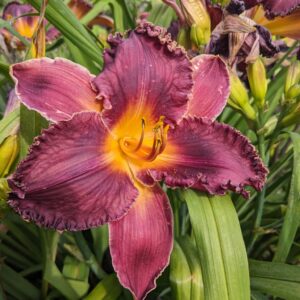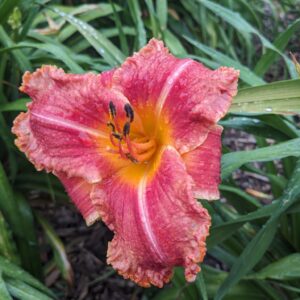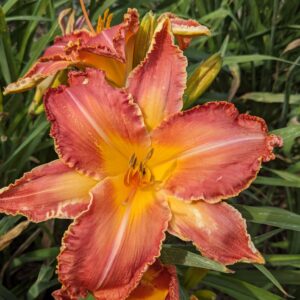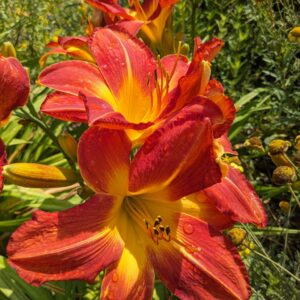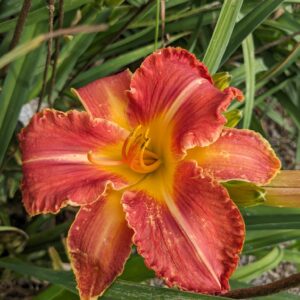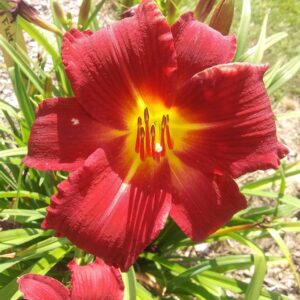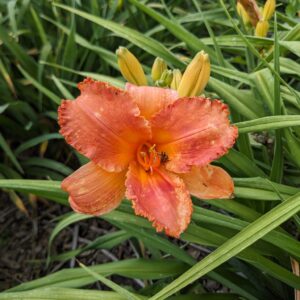Perennials & Biennials
Showing 217–224 of 485 results
-
Hemerocallis ‘Copper daydream’ Z 4-9
Copper blossom golden center with golden stripes radiating to blossom edges. Blooms in July.
Copper blossom golden center with golden stripes radiating to blossom edges.
Blooms in July.Size: 30-36” Blossom 7” across
Care: sun in most any soil -
Hemerocallis ‘Coronation’ Z 4-9
Tetraploid Daylily. Deep royal purple, ruffle-edged blossom with sepals and gentle waves at the margins. Narrow white line outlines at edges of both petals and sepals. Blooms in July.
Tetraploid Daylily. Deep royal purple, ruffle-edged blossom with sepals and gentle waves at the margins. Narrow white line outlines at edges of both petals and sepals. Blooms in July.
Size: 27-32” tall Blossoms 6” across
Care: sun in most any soil.Tetraploid Daylily. Deep royal purple, ruffle-edged blossom with sepals and gentle waves at the margins. Narrow white line outlines at edges of both petals and sepals. Blooms in July.
-
Hemerocallis ‘Cranberry Gold’ Z 4-9
Tetraploid Daylily. Deep pink ruffle-edged petals with white stripe down middle. Sepals recurved, Blooms in July.
Tetraploid Daylily. Deep pink ruffle-edged petals with white stripe down middle. Sepals recurved, Blooms in July.
Size: 27-32” tall Blossoms 5.5” across
Tetraploid Daylily. Deep pink ruffle-edged petals with white stripe down middle. Sepals recurved, Blooms in July.
-
Hemerocallis ‘Daybreak’ Z 4-9
Tetraploid Daylily. Peach-colored blossoms outlined with narrow white line and a white stripe down middle of petals Blooms in July.
Tetraploid Daylily. Peach-colored blossoms outlined with narrow white line and a white stripe down middle of petals Blooms in July.
Size: 24-28” tall Blossoms 7” across
Care: sun in most any soilTetraploid Daylily. Peach-colored blossoms outlined with narrow white line and a white stripe down middle of petals Blooms in July.
-
Hemerocallis ‘Deep Copper’ Z 4-9
Tetraploid Daylily. Dark, nearly red copper blossoms with radiating gold eyes. Petals slightly ruffled, sepals smooth edges. Blooms in July.
Tetraploid Daylily. Dark, nearly red copper blossoms with radiating gold eyes. Petals slightly ruffled, sepals smooth edges. Blooms in July.
Size: 30-42” tall Blossoms 7” across
Care: sun in most any soilTetraploid Daylily. Dark, nearly red copper blossoms with radiating gold eyes. Petals slightly ruffled, sepals smooth edges. Blooms in July.
-
Hemerocallis ‘Grapefruit Mist ’ Z 4-9
Tetraploid Daylily. Blossoms the color of pink grapefruit surrounds the center the color of yellow grapefruit rind with ruffles enclosed by a thin line of yellow blossoms. Slightly ruffled petal edges and smooth sepal edges. Green-gold eye. Blooms in July.
Tetraploid Daylily. Blossoms the color of pink grapefruit surrounds the center the color of yellow grapefruit rind with ruffles enclosed by a thin line of yellow blossoms. Slightly ruffled petal edges and smooth sepal edges. Green-gold eye. Blooms in July.
Size: 24-28” tall. Blossoms 6” across.
Care: sun in most any soilTetraploid Daylily. Blossoms the color of pink grapefruit surrounds the center the color of yellow grapefruit rind with ruffles enclosed by a thin line of yellow blossoms. Slightly ruffled petal edges and smooth sepal edges. Green-gold eye. Blooms in July.
-
Hemerocallis ‘Magic Flute’ Bob’s daylily Z 4-10
This name inspired by Mozart’s opera, a story of light, darkness and finding the way in life. Blooms in July.
This name inspired by Mozart’s opera, a story of light, darkness and finding the way in life. Blooms in July.
Size: 24-28”
Care: sun in most any soilRobert Koehne (April 1971-September 2014) Bob was a good personal friend and very enthusiastic gardener – perennially cheerful. He loved his wife and two children and daylily breeding. These daylilies are his “children” too. He bred them, named them and registered them. He died of colon cancer too soon – before he could grow grey with Darby or see his kids or his daylilies grow up. We are growing on his daylilies. The proceeds go to his family.
-
Hemerocallis ‘Marmalade Skies’ Z 4-8
Tetraploid Daylily. Blossoms the color of pink glazed with tangerine and ruffled petal edges with contrasting straight edged sepals. enclosed by a thin line of yellow. Blossoms enveloping its glowing eye, Blooms in July.
Tetraploid Daylily. Blossoms the color of pink glazed with tangerine and ruffled petal edges with contrasting straight edged sepals. enclosed by a thin line of yellow. Blossoms enveloping its glowing eye, Blooms in July.
Size: 26-30” tall. Blossoms 5.5” across.
Care: sun in most any soilTetraploid Daylily. Blossoms the color of pink glazed with tangerine and ruffled petal edges with contrasting straight edged sepals. enclosed by a thin line of yellow. Blossoms enveloping its glowing eye, Blooms in July.


